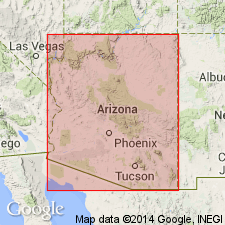
- Usage in publication:
-
- Hindu Canyon Formation
- Modifications:
-
- Named
- Dominant lithology:
-
- Conglomerate
- Sandstone
- Siltstone
- AAPG geologic province:
-
- Plateau sedimentary province
Summary:
Is Tertiary formation, apparently named from its occurrence in Hindu Canyon, a nine-mile-long canyon cut into the Hualapai Plateau of the Grand Canyon area, Mohave Co, AZ (Plateau sedimentary province). Derivation of name is not stated. Type section in Hindu Canyon (sec. 20-25, T27N, R12W, Gila River and the Salt River Principal Meridian). Unconformably overlies lower Paleozoic limestone; unconformably overlain by Tertiary-Quaternary Buck and Doe Conglomerate (new). Is exposed on canyon floor and along the canyon walls. Consists of interbedded conglomerate, sandstone, and siltstone units that interfinger with overlying Buck and Doe Conglomerate. Is subdivided into three informal members: 1) lower member is granitic conglomerate about 150+ feet thick; 2) middle member is limestone conglomerate with interfingered red sandstone units as thick as 20, but total thickness is not stated; and 3) upper member is deep red claystone and siltstone, 0 to 100 feet thick. Formation is of fluvial origin, upper member may be lacustrine in part; no fossils found; at one time the unit completely filled the canyon in excess of 1,000 feet thick; similar deposits occur in the head of Peach Springs Canyon at same elevation (3,600 feet above sea level).
Source: GNU records (USGS DDS-6; Denver GNULEX).
For more information, please contact Nancy Stamm, Geologic Names Committee Secretary.
Asterisk (*) indicates published by U.S. Geological Survey authors.
"No current usage" (†) implies that a name has been abandoned or has fallen into disuse. Former usage and, if known, replacement name given in parentheses ( ).
Slash (/) indicates name conflicts with nomenclatural guidelines (CSN, 1933; ACSN, 1961, 1970; NACSN, 1983, 2005, 2021). May be explained within brackets ([ ]).

